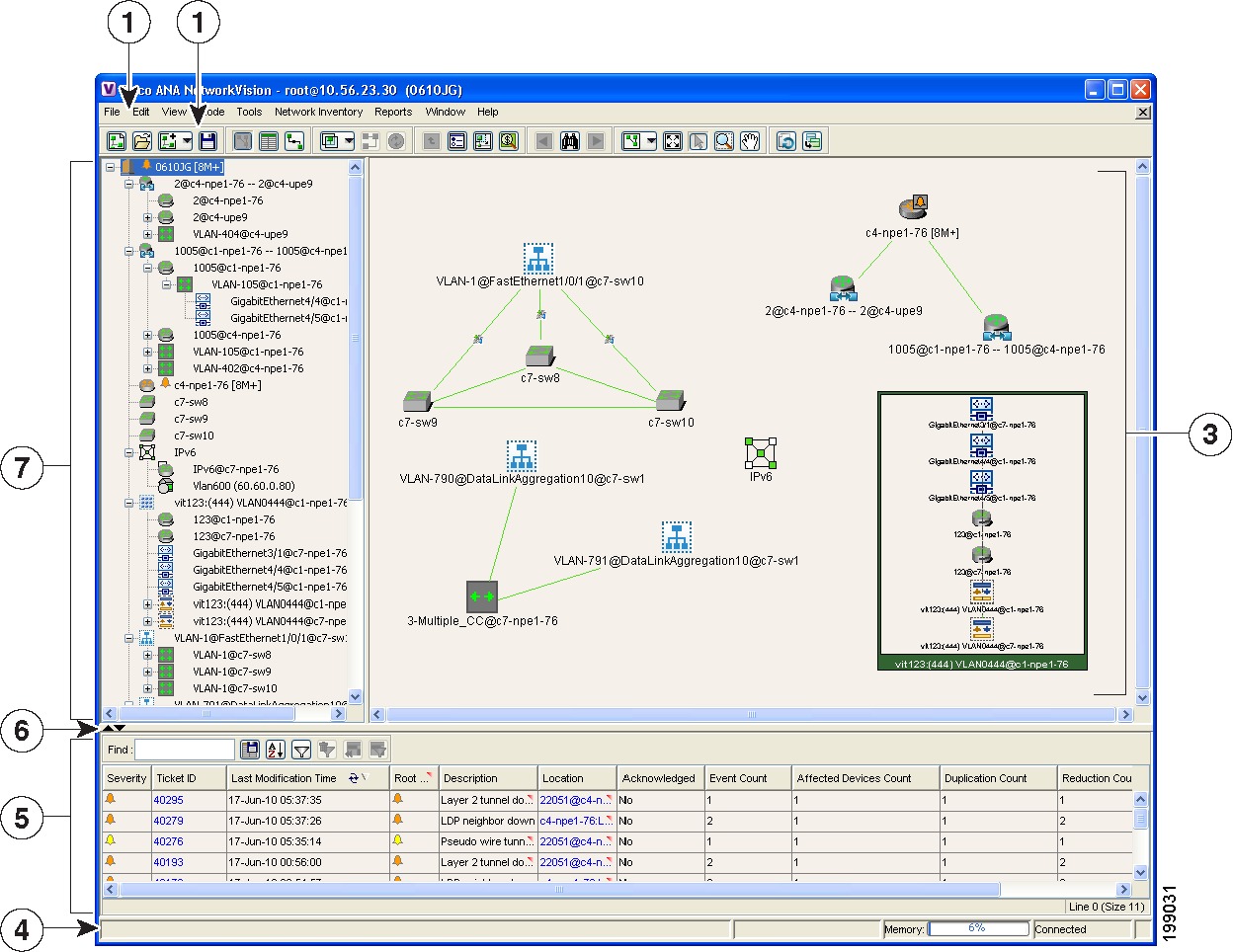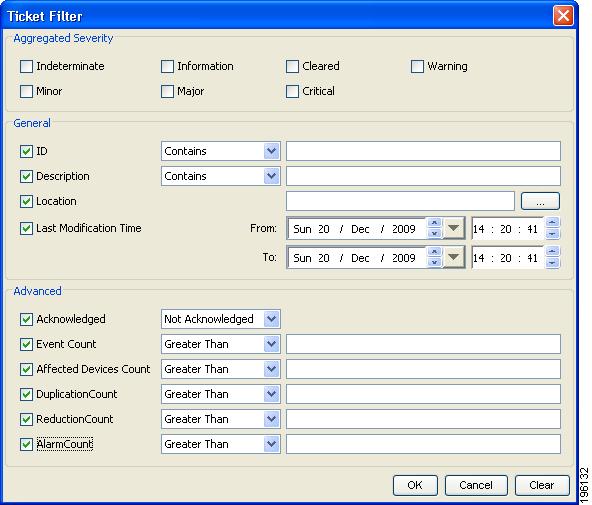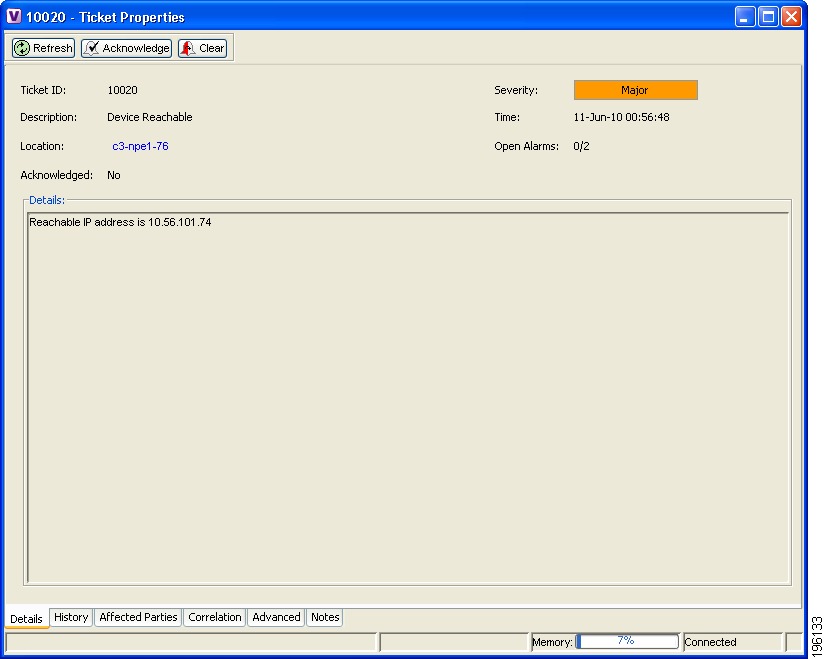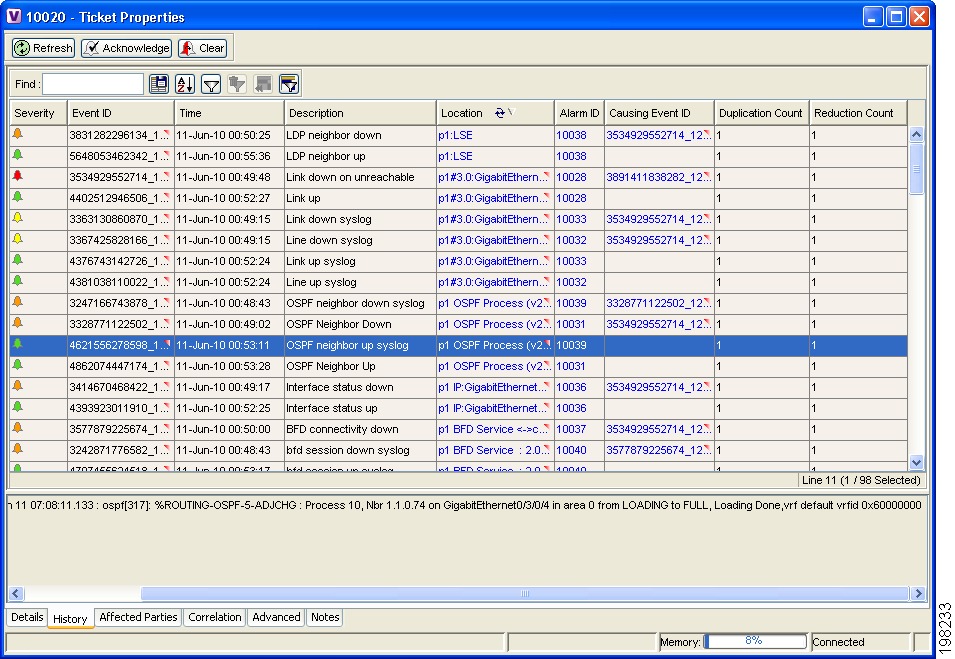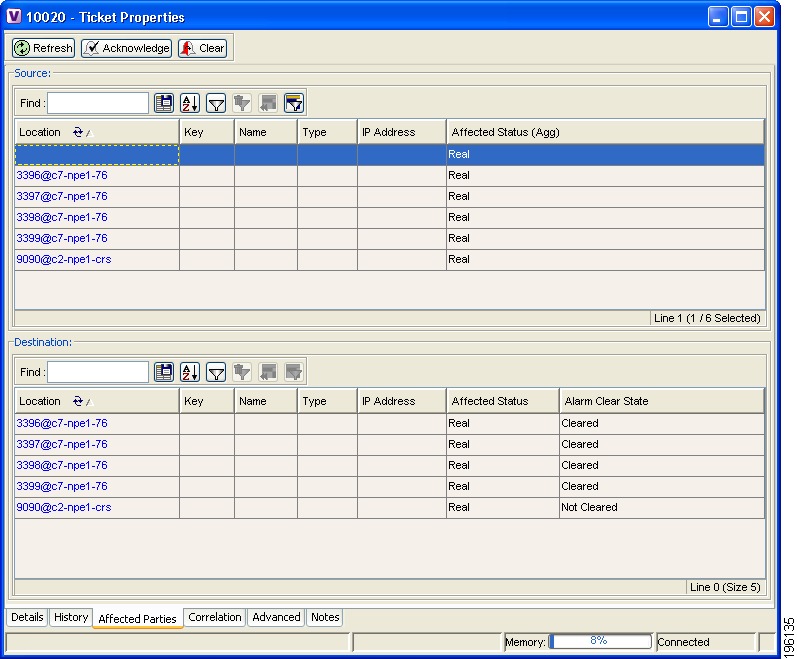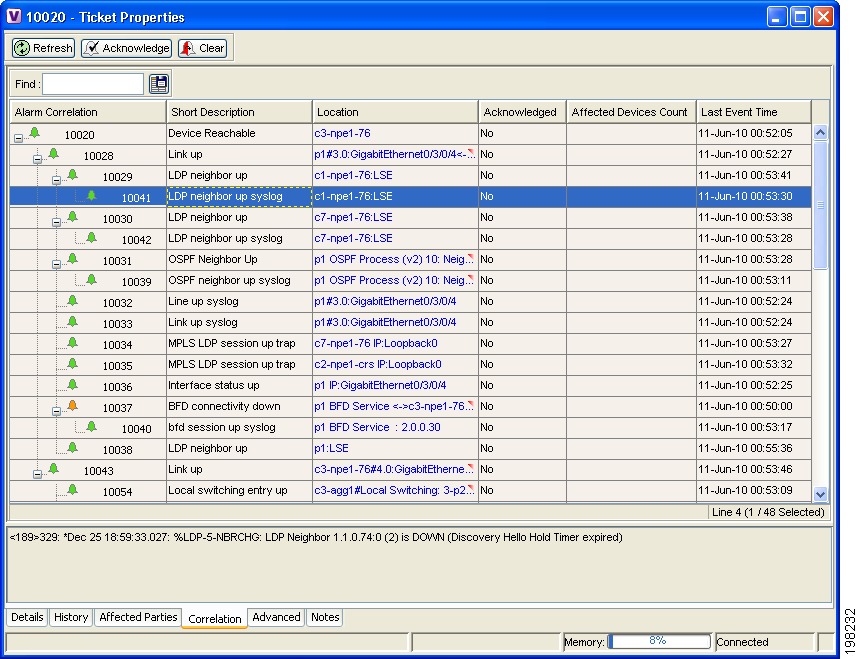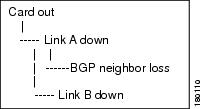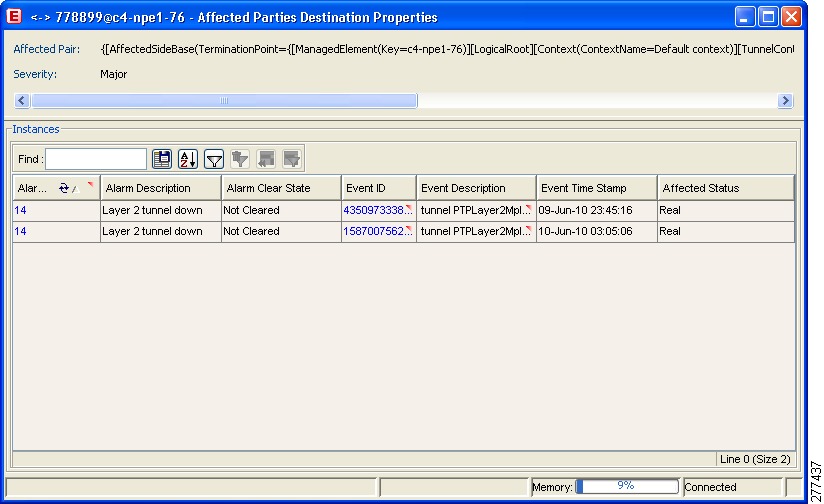

-
Cisco Active Network Abstraction User Guide, 3.7.1
-
Preface
-
Cisco ANA Client Overview
-
Working with the Cisco ANA NetworkVision Client
-
Viewing Network Element Properties
-
Working with Cisco ANA NetworkVision Maps
-
Working with Links
-
Working with Business Tags and Business Elements
-
Working with the Cisco ANA EventVision Client
-
Tracking Faults Using Cisco ANA EventVision
-
Working with Tickets in Cisco ANA NetworkVision
-
Working with Reports
-
Using Cisco ANA PathTracer to Diagnose Problems
-
Monitoring Carrier Ethernet Services
-
Monitoring Carrier-Grade NAT Properties
-
Monitoring DWDM Properties
-
Viewing Ethernet Operations, Administration, and Maintenance Tool Properties
-
IPv6 and IPv6 VPN over MPLS
-
Monitoring MPLS Services
-
Monitoring MToP Services
-
Viewing SBC Properties
-
Icon Reference
-
Index
-
Table Of Contents
Working with Tickets in Cisco ANA NetworkVision
User Roles Required to Work with Tickets in Cisco ANA NetworkVision
Viewing Tickets in Cisco ANA NetworkVision
Ticket Status in the Ticket Pane
Status Values for Affected Parties
Accumulating the Affected Parties in an Alarm
Accumulating the Affected Parties in the Correlation Tree
Updating Affected Severity over Time
Viewing Detailed Information for the Affected Pair
Working with Tickets in Cisco ANA NetworkVision
The following topics describe viewing tickets in Cisco ANA NetworkVision, how to manage tickets that represent fault scenarios of selected devices or network elements, and fault impact analysis:
•
User Roles Required to Work with Tickets in Cisco ANA NetworkVision
•
Viewing Tickets in Cisco ANA NetworkVision
Note
For detailed information about alarms and fault management, see the Cisco Active Network Abstraction 3.7.1 Theory of Operations Guide.
User Roles Required to Work with Tickets in Cisco ANA NetworkVision
Table 9-1 identifies the roles that are required to work with tickets in Cisco ANA NetworkVision. Cisco ANA determines whether you are authorized to perform a task as follows:
•
For GUI-based tasks (tasks that do not affect devices), authorization is based on the default permission that is assigned to your user account.
•
For device-based tasks (tasks that do affect devices), authorization is based on the default permission that is assigned to your account. That is, whether the device is in one of your assigned scopes and whether you meet the minimum security level for that scope.
For more information on user authorization, see the Cisco Active Network Abstraction 3.7.1 Administrator Guide.
Note
If a device that is outside of your scope is the root cause of a ticket that affects a device in your scope, you can view the ticket Cisco ANA NetworkVision, but the ticket will indicate that the root cause is outside of your scope.
Viewing Tickets in Cisco ANA NetworkVision
Tickets are displayed in the ticket pane in Cisco ANA NetworkVision as shown in Figure 9-1.
Figure 9-1 Cisco ANA NetworkVision Window
Menu bar
Ticket pane
Toolbar
Hide/Display ticket pane
Content area
Navigation pane
Status bar
The ticket pane enables you to view and manage tickets as well as find the elements affected by a ticket. All tickets that are reported by Cisco ANA are stored in the Cisco ANA gateway database.
The ticket pane is displayed beneath the navigation and content panes in the Cisco ANA NetworkVision window. You can view or hide the ticket pane by clicking the arrows displayed below the navigation pane.
For more information about the information available in the ticket pane, see Table 2-10 on page 2-16.
The ticket pane enables you to perform the following tasks:
Ticket Status in the Ticket Pane
The appearance of a ticket displayed in the ticket pane depends on the severity of the ticket and the operations that have been performed on the ticket. Tickets detailed in the ticket pane change when:
•
A ticket is generated.
•
A ticket is cleared.
•
A ticket is acknowledged.
•
An Up ticket is generated.
•
A ticket is cleared and removed.
•
A ticket is removed.
•
Other properties are updated, such as severity, description, or counters.
Generated Ticket
Table 9-2 shows an example of the appearance of the ticket pane when a ticket is generated.
Table 9-2 Generated Ticket
(Major)
27
Port down
Yes
Cleared Ticket
Table 9-3 shows an example of the appearance of the ticket pane when a ticket is cleared.
Table 9-3 Cleared Ticket
(Normal)
27
Cleared due to Force Clear
Yes
A ticket that has been cleared can be removed from the ticket pane.
When a ticket is cleared, its definition automatically changes to acknowledged in the ticket pane and its definition in the Acknowledged column is Acknowledged.
Acknowledged Ticket
Table 9-4 shows an example of the appearance of the ticket pane when a ticket is acknowledged. When a ticket is acknowledged it can then be cleared and the severity changes to Normal.
Table 9-4 Acknowledged Ticket
(Major)
27
Port up
Yes
Note
When a ticket with an Information severity is acknowledged, the ticket is automatically removed from the Cisco ANA Gateway and from the ticket pane.
Generated Up Ticket
The cause of the alarm is fixed; therefore an Up ticket is automatically generated with a Normal severity. Table 9-5 shows an example of the appearance of the ticket pane when an Up ticket is generated.
Table 9-5 Generated Up Ticket
(Normal)
27
Port up
Yes
Filtering Tickets by Device
Cisco ANA NetworkVision enables you to filter the tickets that are shown in the ticket pane so that only the tickets of a selected device or network element are displayed.
To filter tickets for a specific network element:
Step 1
Right-click the required device or network element in the navigation pane or a map in the Cisco ANA NetworkVision window to display the Device shortcut menu.
Step 2
Choose Filter Tickets. The ticket pane displays the tickets of the selected device or network element only.
Note
The Filter button in the ticket pane toggles to indicate that a filter has been applied.
The filter can be removed to display all the tickets in the system.
Filtering Tickets by Criteria
Cisco ANA NetworkVision enables you to define a filter for the tickets displayed in the ticket pane according to various criteria. For example, tickets can be filtered according to the number of affected parties or acknowledged tickets.
To define a ticket filter:
Step 1
Click Ticket Filter in the ticket pane toolbar. The Ticket Filter dialog box is displayed (Figure 9-2).
Figure 9-2 Ticket Filter Dialog Box
Step 2
Select the required filter values, and provide any required criteria. For more information about specifying filter criteria, see Table 8-23.
Step 3
Click OK. The filtered tickets are displayed in the ticket pane according to the defined criteria.
Note
The Ticket Filter button in the ticket pane toggles to indicate that a filter has been applied.
To remove a ticket filter:
Step 1
Click Ticket Filter in the ticket pane toolbar. The Ticket Filter dialog box is displayed.
Step 2
Click Clear. The selected options in the Ticket Filter dialog box are cleared.
Step 3
Click OK. All the tickets are displayed in the ticket pane.
Viewing Ticket Properties
The properties of a selected ticket can be viewed by displaying the Ticket Properties window. For example, you can view alarm severity, correlated alarms, active alarms, alarm history, or the source of the alarm.
In Cisco ANA NetworkVision, open the Ticket Properties window in one of the following ways:
•
Open the required map and then double-click the required ticket ID in the ticket pane.
•
Open the required map, right-click a ticket in the ticket pane, and choose Properties.
Figure 9-3 shows the Ticket Properties window.
Figure 9-3 Ticket Properties Window
The information displayed in the Ticket Properties window corresponds with the information displayed in the Cisco ANA NetworkVision ticket pane or the Cisco ANA EventVision window. The ID number displayed in the header corresponds to the ID number of the ticket selected in the ticket pane.
The Ticket Properties window contains the following components:
Toolbar
The Ticket Properties dialog box contains the tools described in Table 9-6.
Table 9-6 Ticket Properties Window Toolbar
Refreshes the information displayed in the Ticket Properties dialog box.
Acknowledges that the ticket is being handled. The status of the ticket is displayed as true in the ticket pane and in the Ticket Properties dialog box. For more information, see Acknowledged Ticket.
If a ticket was acknowledged, and some events were correlated to it afterward, then the ticket is considered to have not been acknowledged.
This button is enabled only if the ticket is not acknowledged.
Requests the relevant Cisco ANA to remove the faulty network element from the Cisco ANA networking inventory. In addition, it sets the ticket to Cleared severity or status (the icon is displayed in green) and automatically changes the acknowledged status of the ticket to true. For more information, see Cleared Ticket.
This button is enabled only if the severity of the alarm is higher than Cleared or Normal.
Saves the notes for the selected ticket.
This button is enabled only when text is entered in the Notes field of the Notes tab.
Details Tab
Table 9-7 describes the information that is displayed in the Details tab about the compiled alarm.
History Tab
The History tab enables you to display the history of the ticket, including all the events. Figure 9-4 shows the History tab.
Figure 9-4 History Tab
Table 9-8 describes the information that is displayed in the History tab.
Affected Parties Tab
The Affected Parties tab displays the service resources (pairs) that are affected by an event, an alarm, or a ticket. When a fault occurs, Cisco ANA automatically calculates the affected parties and embeds this information in the ticket along with all the correlated faults. You can view a list of all the endpoints that are affected.
The Affected Parties tab displays the service resources (affected pairs) that are affected by the ticket.
Figure 9-5 Affected Parties Tab
The Affected Parties tab contains two tables: Source and Destination. Table 9-9 describes the information that is displayed in the Affected Properties tab.
Table 9-9 Ticket Properties Window - Affected Properties Tab
Location
Hyperlinked entry to the port with the affected parties.
Key
Unique value taken from the affected element's business tag key, if it exists.
Name
Subinterface (site) name or business tag name of the affected element, if it exists.
Type
Business tag type.
IP Address
If the affected element is an IP interface, the IP address of the subinterface site.
Affected Status (Agg)
Status for the affected pair (destination). The same source can be part of multiple pairs, and therefore each pair can have a different affected status. The highest affected status reflects the highest among these. The affected status can be one of the following:
•
Potential
•
Real
•
Recovered
•
N/A—From the links view, this indicates Not Applicable.
Location
Hyperlinked entry to the port with the affected parties.
Key
Unique value taken from the affected element's business tag key, if it exists.
Name
Subinterface name or business tag name of the affected element, if it exists.
Type
Business tag type.
IP Address
If the affected element is an IP interface, the IP address of the subinterface site.
Affected Status
Status of the affected pair as calculated by the client according to the rules defined in Status Values for Affected Parties.
Alarm Clear State
For each pair, an indication of the clear state of the alarm:
•
Cleared—All related alarms for this pair have been cleared.
•
Not Cleared—One or more alarms for this pair have not been cleared.
When an affected side is selected in the Source table, the Destination table lists all endpoints with services that have been affected between them and the entry selected in the Source table.
In addition, for every affected pair, you can view detailed information that includes a list of the events that contributed to this affected pair. For more information, see Viewing Detailed Information for the Affected Pair.
Note
The Affected Parties dialog box occasionally displays entries that start with the word Misconfigured. Entries that start with Misconfigured indicate that the flow has stopped unexpectedly between the source and destination points. An unexpected termination point can be a routing entity, bridge, or VC switching entity. The significant aspects of Misconfigured entries are:
- Because the link does not terminate as expected, the link is not actually impacted.
- An error might exist in the configuration or status of the termination points. We recommend that you check the configuration and status of the affected termination points.
Correlation Tab
The Correlation tab displays all the alarms that are correlated to the selected ticket.
Figure 9-6 Correlation Tab
Table 9-10 describes the information that is displayed in the Correlation tab.
Advanced Tab
The Advanced tab displays the following values for the selected ticket:
•
Duplication Count:
–
For network events, the duplication count is calculated by the VNE and pertains only to flapping events. The duplication count represents the number of noncleared events aggregated by the flapping event.
–
For tickets, the duplication count is the sum of the duplication counts of all events that are associated with the root alarm.
•
Reduction Count:
–
For network events, the reduction count is calculated by the VNE and pertains only to flapping events. The reduction count represents the number of events that are aggregated by the flapping event.
–
For tickets, reduction count is the sum of reduction counts of all the events that are associated to the ticket. The History tab in the Windows Properties window displays one reduction count for each event listed.
•
Affected Devices—The number of devices affected by the ticket.
•
Alarm Count—The total number of alarms associated with the ticket, including the root alarm.
Notes Tab
The Notes tab enables you to add and save notes for the selected ticket. To add text, enter text in the Notes field and click Save Notes. The new text is added to any previously existing text.
The following restrictions apply to the Notes tab:
•
The Notes tab is not available for archived tickets.
•
The Save Notes button is enabled only when text is entered in the Notes field.
•
The text cannot be edited or removed once you have saved the notes.
Managing Tickets
The following topics describe how to manage tickets:
•
Clearing and Removing Tickets
Finding Affected Elements
To locate elements affected by a ticket in Cisco ANA NetworkVision, right-click the desired ticket in the ticket pane and then choose Find Affected Elements.
Depending on the number of affected elements, the results are displayed in one of the following ways:
•
If only one element is affected, it is highlighted in the navigation pane and the content area.
•
If multiple elements are affected, they are displayed in the Affected Events window.
Acknowledging a Ticket
When an alarm occurs, a warning or ticket is displayed in the ticket pane. Cisco ANA NetworkVision enables you to handle the status of a ticket by acknowledging it. This acknowledges the fault.
The change is reported to the Cisco ANA gateway and all open Cisco ANA NetworkVision applications. You can acknowledge multiple tickets at the same time.
An acknowledged ticket returns to a status of Not Acknowledged when a new event is correlated to it.
Note
You cannot undo this operation.
To acknowledge one or more tickets, do one of the following:
•
Select one or more tickets in the ticket pane, and then right-click and choose Acknowledge.
•
Double-click a ticket in the ticket pane and click Acknowledge.
For more information, see Ticket Status in the Ticket Pane.
Clearing a Ticket
When an alarm occurs, a warning or ticket is displayed in the ticket pane. Cisco ANA NetworkVision enables you to handle the reported ticket by verifying the report of what is faulty and clearing the faulty network element. The change is reported to the Cisco ANA gateway and all open Cisco ANA NetworkVision applications. This operation cannot be reversed.
You can clear multiple tickets at the same time.
Note
Before using Clear and Remove (which might also be available when you right-click a ticket), be sure you understand the results of removing a ticket. Like clearing a ticket, removing a ticket cannot be reversed. See Removing a Ticket.
Clearing an open ticket performs the following operations:
•
For certain network elements, such as cards and links, sends a request to the Cisco ANA system to remove the faulty network element from the Cisco ANA networking inventory.
•
Sets the alarm to Cleared or Normal severity or status by issuing a corresponding Clear alarm.
•
Automatically sets the alarm severity or status to acknowledged (true).
To clear one or more tickets, do one of the following:
•
Select one or more tickets in the ticket pane, and then right-click and choose Clear.
•
Double-click a ticket in the ticket pane and click Clear.
For more information, see Ticket Status in the Ticket Pane.
Removing a Ticket
When an alarm occurs, a warning or ticket is displayed in the ticket pane. Cisco ANA NetworkVision enables you to completely remove the ticket and all of its active alarms and business tags. The change is reported to the Cisco ANA gateway and all instances of Cisco ANA NetworkVision that are open. In addition, several tickets can be removed at the same time. After a ticket is cleared or an Up alarm occurs, the ticket can be removed.
You can remove multiple tickets at the same time.
Note
This operation cannot be reversed. A ticket that has been removed can be viewed only by using Cisco ANA EventVision.
Removing a ticket performs the following operations:
•
For certain network elements, such as cards or links, sends a request to the Cisco ANA system to remove the faulty network element from the Cisco ANA networking inventory.
•
Archives the ticket and active alarms.
•
Notifies all open instances of Cisco ANA clients (Cisco ANA NetworkVision or BQL) that are registered on the ticket that the ticket has been removed and deletes the ticket from the ticket pane.
Note
Only tickets with a severity of Cleared, Normal, or Information can be removed.
To remove one or more tickets, select the required tickets in the ticket pane, and then right-click and choose Remove.
For more information, see Ticket Status in the Ticket Pane.
In addition, an uncleared ticket (which has a severity higher than Cleared or Normal) can be cleared and removed by right-clicking in the ticket pane and choosing Clear and Remove. For more information about the Ticket shortcut menu, see Ticket Shortcut Menu, page 2-37.
Clearing and Removing Tickets
Clearing and removing a ticket:
•
Approves the reported faulty ticket.
•
Clears the faulty networking entity from Cisco ANA.
•
Archives the ticket.
You can clear and remove multiple tickets at the same time.
To clear and remove one or more tickets, select the required tickets in the ticket pane, and then right-click and choose Clear and Remove.
Impact Analysis in Cisco ANA
Impact analysis enables you to identify the network elements and services that are impacted by a network fault or outage.
Cisco ANA offers two modes of impact analysis:
•
Automatic impact analysis—When a fault occurs that has been identified as potentially service affecting, Cisco ANA automatically generates the list of potential and actual service resources that were affected by the fault, and embeds this information in the ticket along with all the correlated faults.
Note
This applies only to specific alarms. Not every alarm initiates automatic impact analysis.
•
Proactive impact analysis—Cisco ANA provides what-if scenarios for determining the possible effect of network failures. This enables on-demand calculation of affected service resources for every link in the network, thus enabling an immediate service availability check and analysis for potential impact and identification of critical network links. Upon execution of the what-if scenario, Cisco ANA initiates an end-to-end flow that determines all the potentially affected edges.
Note
Each fault that has been identified as potentially service affecting triggers an impact analysis calculation, even if the fault recurs in the network.
Status Values for Affected Parties
In automatic mode, the affected parties can be marked with one of the following status values:
•
Potential—The service might be affected but its actual state is not yet known.
•
Real—The service is affected.
•
Recovered—The service has recovered. This state relates only to entries that were marked previously as potentially affected. It indicates only the fact that there is an alternate route to the service, regardless of the service quality level.
Initially, Cisco ANA might identify the services as either potentially or real affected. As time progresses and more information is accumulated from the network, Cisco ANA updates the information to indicate which of the potentially affected parties are real or recovered.
The indications for these states are available both through the API and in the GUI.
Note
There is no clear state for the affected services when the alarm is cleared.
Accumulating Affected Parties
During automatic impact analysis, Cisco ANA NetworkVision automatically calculates the accumulation of affected parties. This information is embedded in the ticket along with all of the correlated faults.
In the following example, these alarm types exist in the correlation tree:
•
Ticket root-cause alarm (Card Out).
•
An alarm which is correlated to the root cause and has other alarms correlated to it (Link A Down).
•
An alarm with no other alarms correlated to it (Link B Down and BGP Neighbor Loss).
An event sequence is correlated to each of these alarms.
Figure 9-7 Correlation Tree Example
Cisco ANA NetworkVision identifies the affected parties for each type of alarm and accumulates the following information:
•
The affected parties reported on all the events in the alarm event sequence, including flapping alarms.
•
The affected parties reported on the alarms that are correlated to it.
The gathered information includes the accumulation of the affected report of all the events in its own correlation tree.
For example, in Figure 9-7:
•
BGP neighbor loss includes the affected parties of all events in its own event sequence.
•
Link A Down includes the affected parties of its own event sequence and the accumulated information of the BGP Neighbor Loss event.
Accumulating the Affected Parties in an Alarm
If two events form part of the same event sequence in a specific alarm, the recurring affected pairs are displayed only once in the Affected Parties tab. If different affected severities are reported for the same pair, the pair is marked with the severity that was reported by the latest event, according to the time stamp.
Accumulating the Affected Parties in the Correlation Tree
If two or more alarms that are part of the same correlation tree report on the same affected pair of edgepoints and have different affected severities, the recurring affected pairs are displayed only once in the Affected Parties tab. If different affected severities are reported for the same pair, the pair is marked with the highest severity.
For example, assume that X and Y are the OIDs of edgepoints in the network, and a service is running between them. Both alarms, Link B Down and BGP Neighbor Loss, report on the pair X < > Y as affected:
•
Link B Down reports on X < > Y as potentially affected.
•
BGP Neighbor Loss reports on X < > Y as real affected.
The affected severity priorities are:
•
Real—Priority 1
•
Recovered—Priority 2
•
Potential—Priority 3
Card Out reports on X < > Y as real, affected only once.
Updating Affected Severity over Time
In some cases, Cisco ANA updates the affected severity of the same alarm over time because the effect of the fault on the network cannot be determined until the network has converged.
For example, a Link Down alarm creates a series of affected severity updates over time. These updates are added to the previous updates in the system database. In this case, the system provides the following reports:
•
The first report of a link down reports on X < > Y as potentially affected.
•
Over time, the VNE identifies that this service is real affected or recovered, and generates an updated report.
•
The Affected Parties tab of the Ticket Properties dialog box displays the latest severity as real affected.
•
The Affected Parties Destination Properties dialog box displays both reported severities.
This functionality is available only in the link-down scenario in MPLS networks.
Disabling Impact Analysis
You can disable impact analysis for a specific alarm. If impact analysis is disabled, the system reports the event with no impact information. The settings can be changed dynamically during system runtime.
For more information about disabling impact analysis for specific alarms, see the Cisco Active Network Abstraction 3.7.1 Customization User Guide.
Viewing Detailed Information for the Affected Pair
You can view detailed information for every affected pair in Cisco ANA NetworkVision. The detailed information includes a list of the events that contributed to the affected pair.
To view detailed information for the affected pair:
Step 1
Open the Ticket Properties window for the required ticket, as described in Affected Parties Tab.
Step 2
Click the Affected Parties tab.
Step 3
In the Source table, click the required entry.
Step 4
In the Destination table, right-click the required entry, then choose Detailed List.
The Affected Parties Destination Properties window is displayed.
Figure 9-8 Affected Parties Destination Properties Window
Table 9-11 describes the information that is displayed in the Affected Parties Destination Properties window. Each row in the Instances table represents an event that was reported for the affected pair.
The contains a list of pairs of endpoints when the service between them has been affected.
Table 9-11 Affected Parties Destination Properties Window
Affected Pair
Identifiers for the affected pair.
Affected Severity
The status of the selected link as calculated by the client according to the rules defined in Status Values for Affected Parties. Possible values include:
•
Potential
•
Real
•
Recovered
Severity
The severity of the alarm, such as Major, Minor, or Normal.
For more information, see Severity Indicators, page 2-10.
Alarm OID
Identifier of the alarm to which the event is correlated as a hyperlink to the alarm's properties.
Alarm Description
Description of the alarm to which the event is correlated.
Alarm Clear State
For each pair, the clear state of the alarm:
•
Cleared—All the related alarms for this pair have been cleared.
•
Not Cleared—One or more alarms for this pair have not been cleared.
Event ID
Event identifier as a hyperlink to the relevant event's properties.
Event Description
Description of the event.
Event Timestamp
Date and time at which the event was created.
Affected Status
Status of the affected pair as calculated by the client according to the rules defined Status Values for Affected Parties.

 Feedback
Feedback
